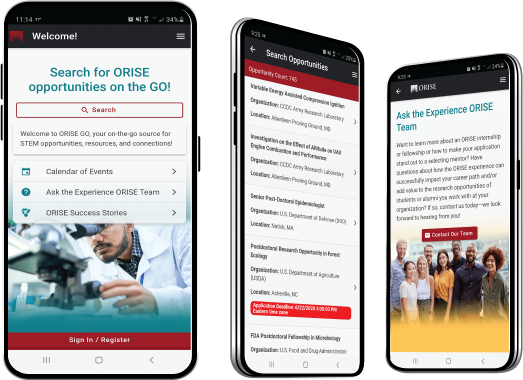EPA Near Source Dispersion Modeling Fellowship
Connect with ORISE...on the GO! Download the new ORISE GO mobile app in the Apple or Google Play Store to help you stay engaged, connected, and informed during your ORISE experience and beyond!
-
An application
-
Transcript(s) – For this opportunity, an unofficial transcript or copy of the student academic records printed by the applicant or by academic advisors from internal institution systems may be submitted. All transcripts must be in English or include an official English translation. Click here for detailed information about acceptable transcripts.
-
A current resume/CV, including academic history, employment history, relevant experiences, and publication list
-
Two educational or professional recommendations. Click here for detailed information about recommendations.
*Applications may be reviewed on a rolling-basis and this posting could close before the deadline. Click here for information about the selection process.
EPA Office/Lab and Location: A research opportunity is available at the Environmental Protection Agency (EPA), Office of Research and Development (ORD), Center for Environmental Measurement and Modeling (CEMM), Atmospheric and Environmental Systems Modeling Division (AESMD) located in Research Triangle Park, North Carolina.
EPA’s Office of Research and Development is focused on enhancing air quality modeling approaches to inform regulatory decisions for permitting and characterization stationary sources, specific attention to near-source air quality modeling capabilities.
Research Project: This research project is focused on the near-source area, including building affected dispersion (e.g., building downwash) and dispersion of mobile source emissions (near-road barrier and depressed roadway effects), and boundary layer characterizations in urban areas.
The research participant will collaborate with an interdisciplinary team dedicated to enhancing EPA’s air quality modeling capabilities for near-source applications. The research participant may evaluate and analyze pollutant patterns resulting from meteorological wind tunnel studies, computation fluid dynamics simulations, field studies, and plume dispersion modeling to further develop fine scale, near-field dispersion modeling approaches. Analyses will focus on the development and improvement of the EPA's AERMOD dispersion model, which is used in all 50 states for a wide variety
of air quality evaluations, including air quality permitting, transportation hot-spot conformity, air toxics evaluations, National Environmental Policy Act demonstrations, and health impact studies.
The research participant may be involved with the following activities:
- Evaluating and analyzing pollutant patterns resulting from
- Meteorological wind tunnel studies;
- Computation fluid dynamics simulations;
- Field studies;
- Plume dispersion modeling;
- Developing near-field dispersion modeling approaches with a specific focus on the AERMOD dispersion model
Learning Objectives: The research participant will have the opportunity to acquire hands-on experience in performing analyses of experimental datasets and in understanding the intricacies of air quality modeling in the near-field environment. Activities performed by the research participant may contribute to a manuscript to be submitted to a peer-reviewed journal. The research participant may have the opportunity to present ORISE research project results at a scientific conference/workshop.
Mentor(s): The mentor(s) for this opportunity are Chris Owen (owen.chris@epa.gov) and David Heist (heist.david@epa.gov). If you have questions about the nature of the research please contact the mentor(s).
Anticipated Appointment Start Date: August 1, 2022. All start dates are flexible and vary depending on numerous factors. Click here for detailed information about start dates.
Appointment Length: The appointment will initially be for one year and may be renewed upon EPA recommendation and subject to availability of funding.
Level of Participation: The appointment is full-time.
Participant Stipend: The participant will receive a monthly stipend commensurate with educational level and experience. Click here for detailed information about full-time stipends.
EPA Security Clearance: Completion of a successful background investigation by the Office of Personnel Management (OPM) is required for an applicant to be on-boarded at EPA.
ORISE Information: This program, administered by ORAU through its contract with the U.S. Department of Energy (DOE) to manage the Oak Ridge Institute for Science and Education (ORISE), was established through an interagency agreement between DOE and EPA. Participants do not become employees of EPA, DOE or the program administrator, and there are no employment-related benefits. Proof of health insurance is required for participation in this program. Health insurance can be obtained through ORISE.
ORISE offers all ORISE EPA graduate students and Postdocs a free 5 year membership to the National Postdoctoral Association (NPA).
The successful applicant(s) will be required to comply with Environmental, Safety and Health (ES&H) requirements of the hosting facility, including but not limited to, COVID-19 requirements (e.g. facial covering, physical distancing, testing, vaccination).
Questions: Please see the FAQ section of our website. After reading, if you have additional questions about the application process please email ORISE.EPA.ORD@orau.org and include the reference code for this opportunity.
The qualified candidate should be currently pursuing or have received an associate's, bachelor's, master's or doctoral degree in one of the relevant fields (e.g. Environmental or Atmospheric Science, Mechanical or Civil Engineering, Meteorology). Degree must have been received within five years of the appointment start date.
- Familiarity with Windows-based computational tools (e.g. Matlab, R, etc). The AERMOD model is largely written in Fortran and any experience with that programming language is an asset
- Experience with GIS
- The research participant will learn to run, analyze, and interpret field, laboratory and air quality model data, and may, as their interest dictates, gain experience with other models and tools
- Citizenship: U.S. Citizen Only
- Degree: Associate's Degree, Bachelor's Degree, Master's Degree, or Doctoral Degree received within the last 60 months or currently pursuing.
- Discipline(s):

 ORISE GO
ORISE GO

The ORISE GO mobile app helps you stay engaged, connected and informed during your ORISE experience – from application, to offer, through your appointment and even as an ORISE alum!





